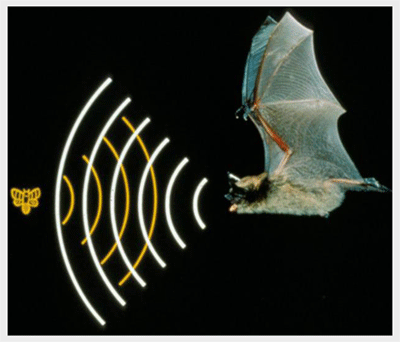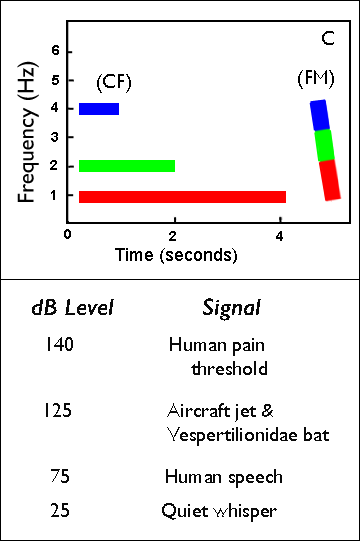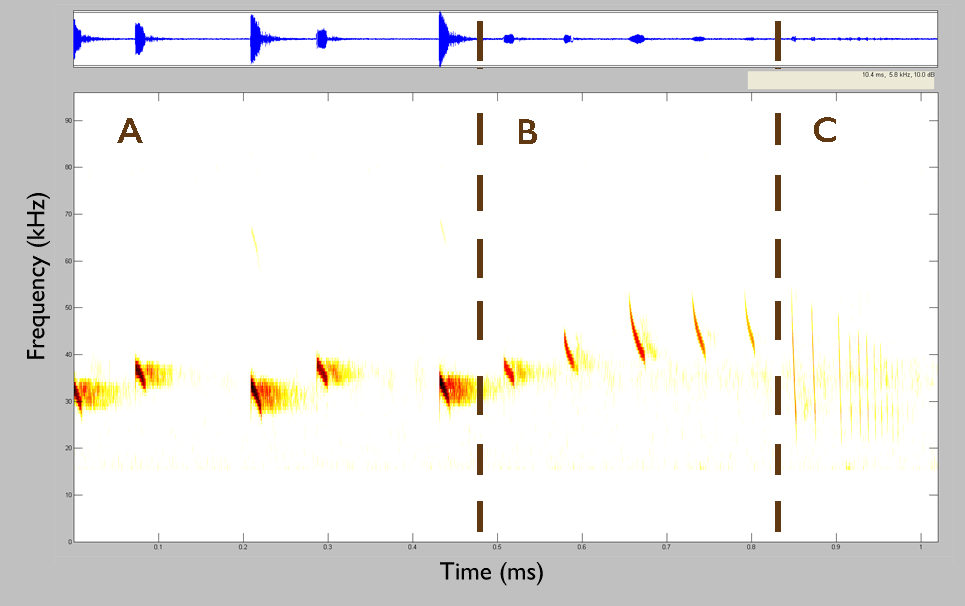 "Echolocation" describes how an animal uses echoes from sound it produces to locate objects in its path.
Echolocation is best known from bats, but it is not unique nor is it a defining feature: other well-known
echolocators are dolphins, porpoises, and toothed whales and even some sightless humans are able to use echolocation to navigate.
And there is an entire family of bats called Pteripodidae (Old World Fruit Bats) which don't echolocate!
"Echolocation" describes how an animal uses echoes from sound it produces to locate objects in its path.
Echolocation is best known from bats, but it is not unique nor is it a defining feature: other well-known
echolocators are dolphins, porpoises, and toothed whales and even some sightless humans are able to use echolocation to navigate.
And there is an entire family of bats called Pteripodidae (Old World Fruit Bats) which don't echolocate!
Echolocation requires the active production of a pulse of sound (signal) and the receipt of the echo before producing the next signal. The differences between the original signal and its echoes contain the raw data necessary for echolocation. Successful echolocation enables a bat to fly around inside a dark cave and not smack into the walls or collide with other bats; it enables bats to travel at night and not collide with trees; and it enables bats to locate, identify, track, and successfully capture prey.
To appreciate what each species of bat is accomplishing in its own unique way, we need to understand a few basic features of sound.
Sound is produced by cycles of changes in pressure which can get transmitted through various media, including air and water. These changes in pressure can be plotted as waves, with characteristics of:
- Frequency = number of cycles of pressure change with respect to time
- Hertz (Hz) = the SI unit of frequency, equal to one cycle per second; 1000 cycles per second equals 1 KiloHertz (kHz)
- Amplitude = the height of the pressure wave, which corresponds to the intensity of the sound and is measured in decibels (dB).
- Wavelength = the distance covered by one cycle and which is dependent upon the velocity of sound. In air at sea level, this is about 340 meters per second. Thus, the wavelength of a 340 Hz note would be one meter while that of a 3.4 kHz note would be 10 cm. The wavelength of a 34 kHz note (which is what the Free-tailed Bat Tadarida brasiliensis uses), is a mere 1 cm.
| |
 |
 Audible vs. Ultrasonic
Audible vs. Ultrasonic
Although Vespertilionidae bats are shouting as loudly as an aircraft jet engine, humans can't hear them because the frequency of their calls is beyond our range of hearing. We are able to hear sounds with frequencies ranging from 12 Hz to 15,000 Hz (i.e., 15 kHz). Below 12 Hz is considered subsonic (e.g. like the songs of whales) and ultrasonic is > 20 kHz. In order to hear ultrasonic sounds, we need special equipment -- "Bat Detectors" -- to convert the wavelengths to human hearing range.
Before we look more closely at the ultrasonic sounds of bats, it helps to remember several general rules of wave propagation:
Many bats produce ecolocation pulses that cover a range of frequencies. The range of frequencies is the "bandwith" of the signal. And a bat will put more (or less) energy into some frequencies of the signal than it does into others, particularly when it shifts from travel mode to object detection, object identification, and finally object capture (or, attempt to capture . . .).
We can see this in the one-second call sequence of a Pallas' Free-tailed Bat (Molossus molossus), hunting in the open air space over Windsor House (visually estimated to have been about 20 m above ground). The series begins with a "narrowband, intense" search phase (A), transitions to "higher maximum frequency, broader bandwidth, medium intensity" for an object-detected / approach-object phase (B), and "broadest bandwith, short pulse interval, quiet" (i.e., best resolution) phase (C) as the bat attempts to capture whatever insect was flying around. This final phase (C) is typically called the "terminal buzz" phase of an insectivore's call. Unfortunately, we can't tell from the call whether the bat successfully captured the insect, but it gave a good try. The "detection of enemy sonar" and avoidance behaviour by insects is a whole other exciting story.
 |
To see more examples of the echolocation calls of Jamaican bats, following the links on our Checklist.

